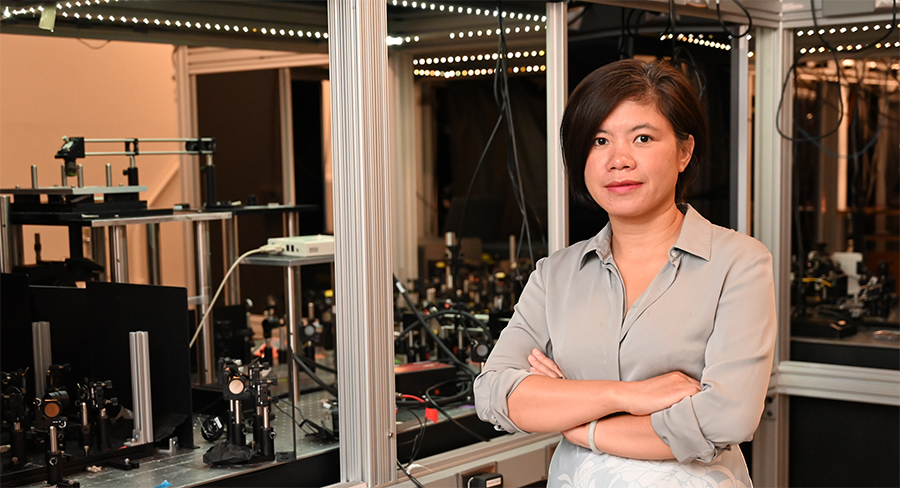
Purdue chemists control artificial atoms in quantum materials with a ‘twist’
2025-03-03
Writer(s): Steve Scherer
An international team of scientists is manipulating moiré superlattices of two-dimensional materials to design and analyze novel quantum materials properties.
“By taking two very thin layers of this new type of crystal material, stacking them on top of each other, and twisting these layers – or rotating them – we found that you can get different properties,” said Libai Huang, professor in Purdue University’s James Tarpo, Jr. and Margaret Tarpo Department of Chemistry.
To visualize this on a large scale, Huang says to think of these superlattices like two pieces of screen cut from a screen door.
“When you place the screen layers on top of each other and change their geometry by twisting them, a moiré pattern emerges,” explained Huang, who is director of the Quantum Photonic Integrated Design Center (QuPIDC), a Department of Energy (DOE) Energy Frontier Research Center (EFRC) led by Purdue.
The scientists used the moiré ‘twist’ to trap exciton particles, and in newly published research in Nature Materials, they are now discovering how to manipulate the trapped excitons.
“An exciton is like an artificial atom. Not only are we trapping them in a location that we want, we’re now manipulating the moiré superlattice and observing how excitons are moving in time and space – analyzing the patterns that they form to understand how these particles are interacting with each other,” explained Huang, who is part of the research team that includes scientists from the University of Washington, RWTH Aachen University, and the Max Planck Institute the Structure and Dynamics of Matter.
Huang, who is a member of the Purdue Quantum Science and Engineering Institute, says the scientists are using laser microscopy to hit the moiré superlattice with a laser beam to analyze the emission at liquid helium temperature.
Huang says the beauty of this moiré superlattice is the ability to generate arrays of excitons with controlled interactions. Surprisingly, the team found that strong repulsive interactions among excitons can freeze their motion into a crystal-like phase known as a Mott insulator.
“These findings challenge the conventional view that repulsion disperses particles while attraction binds them. Instead, the freezing of exciton motion due to strong repulsion is characteristic of highly coherent systems – a feature previously observed only in ultracold gases. This discovery opens new possibilities for exploring quantum coherence and interactions in solid-state systems,” Huang said.
The research is primarily funded by the U.S. Department of Energy, Office of Basic Energy Sciences.
Quantum research is one of four key pillars of the Purdue Computes initiative, which emphasizes the university’s extensive technological and computational environment.
About Purdue Chemistry
The Tarpo Department of Chemistry is internationally acclaimed for its excellence in chemical education and innovation, boasting two Nobel laureates in organic chemistry, the #1 ranked analytical chemistry program, and a highly successful drug discovery initiative that has generated hundreds of millions of dollars in royalties.
About Purdue University
Purdue University is a public research university leading with excellence at scale. Ranked among top 10 public universities in the United States, Purdue discovers, disseminates and deploys knowledge with a quality and at a scale second to none. More than 107,000 students study at Purdue across multiple campuses, locations and modalities, including more than 58,000 at our main campus in West Lafayette and Indianapolis. Committed to affordability and accessibility, Purdue’s main campus has frozen tuition 13 years in a row. See how Purdue never stops in the persistent pursuit of the next giant leap — including its comprehensive urban expansion, the Mitch Daniels School of Business, Purdue Computes and the One Health initiative — at https://www.purdue.edu/president/strategic-initiatives/.